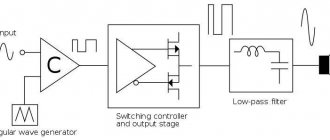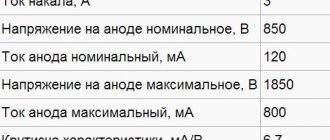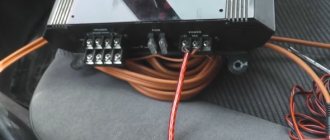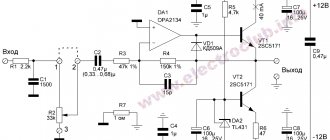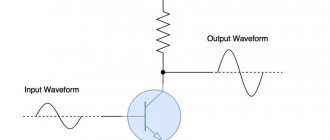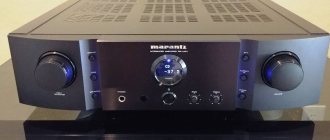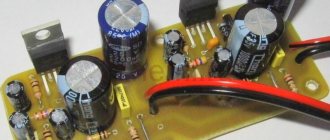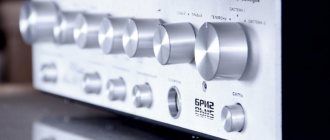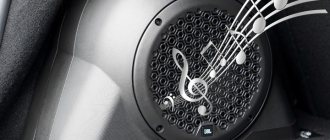The article discusses the characteristics of the TPA3116D2 chip (from the datasheet), which is part of the popular series of modern digital (pulse) audio amplifiers TPA31xxD2 class D from Texas Instrument. These compact products are designed to amplify both mono (PBTL) and stereo (BTL) audio. They have advanced modulation that helps suppress distortion and interference. They support the inclusion of several similar devices in a chain like master-slave to create various circuits based on it.
As you know, ULF class D steel has been mass produced relatively recently. They please with their small dimensions, very low current consumption and high amplification efficiency (up to 90%) compared to their analog counterparts A and AB. At the same time, they are quite demanding on the quality of power supplies, but with the correct selection of connecting components they provide very good sound quality, especially at low frequencies. It is not surprising that their use is becoming more frequent every year.
Main characteristics
According to the datasheet, tpa3116d2 is designed to work with external 100 W dynamic heads into a 2 ohm load in mono mode. It is also capable of providing output power for two channels (2×50 W) into 4 Ohms - a bridge circuit. It is worth considering that these values can only be obtained by supplying the board with voltage from a 24 V power supply with a current of 6 A. Using two microcircuits, you can assemble a modern 100 W class D stereo amplifier. In this case, one device will be used for each channel . Such products get very hot during operation, so a radiator is required for them.
Maximum parameters
The device in question is characterized by a low level of nonlinear distortion (<0.1%) and a high signal-to-noise ratio (102 dB) at the output. Equipped with built-in protection against short circuit, overheating, exceeding the DC current limit, overvoltage and undervoltage.
Limit values of the main operational characteristics tpa3116d2:
- output power (PO):
- 2×50 W (stereo); 1x100W (mono);
- maximum power supply (VCC) up to +30 V;
- voltage at audio inputs (VI) from -0.3 to 6.3 V;
- THD < 0.1%;
- PWM frequency - up to 1.2 MHz;
- temperature: operating (TA) from -40 to +85 oC; crystal (TJ) from -40 to +150 oC; storage (Tstg) from -40 to +120 oC.
Despite the fact that the product in question has protection mechanisms, it is not recommended to exceed the specified parameters.
Class D mini amplifier on TPA3116 with Bluetooth 5, USB and Aux for pennies!
I absolutely welcome you!
Today I’ll talk a little about the Chinese class D mini-amplifier based on the rather successful TPA3116 chip. Reviewing music devices is a thankless task, but I'll try. Class D amplifiers were almost immediately given the offensive label “digital amplifier”; in fact, it would be more correct to call it a pulse amplifier. The operation is based on the principle of Pulse Width Modulation (PWM). The main advantage of class D amplifiers is energy efficiency (90% or more) and a large increase in efficiency. For example, to obtain a power of 100-150 W at the output of a class AB amplifier, the amplifier must have a radiator that occupies one or two walls of the case, while a class D amplifier will make do with an aluminum radiator the size of a box of matches. The size of the board is also reduced several times, and, as a result, the cost of the device is lower.
However, Class D amplifiers also have weaknesses that have prevented them from completely taking over the HIFI segment. The presence of a high-frequency generator in a microcircuit can cause electromagnetic interference, which negatively affects the sound of the device. The high efficiency of class D amplifiers has also caused the sound quality to depend on the quality of the power supply. If the switching power supply does not have a sufficient number of filters, some of the noise will definitely penetrate the speakers and ruin the entire positive impression of the sound.
Mini Amplifier with bluetooth 5.0 AUX and USB on TPA3116 $17.99 WITH COUPON "BGFCTPA"
alternative amplifier models on TPA3116
excellway power supply 9-24V
Purpose of TPA3116 chips:
- Soundbars
- TVs
- Consumer audio
Characteristics:
- Bluetooth 5.0
- OTG function
- Hi-Fi sound
- noise suppression system
- bluetooth: 5.0, distance up to 12m
- Inputs: 3.5mm AUX, bluetooth, USB,
- RCA, TF memory card
- Outputs: Banana Speaker Jacks
- Amplifier chip: TPA3116
- Power: 100W, 50Wx2 Max (24V/4Ω)
- Speaker impedance: 4Ω-16Ω
- Frequency range: 20Hz-20KHz(±1dB)
- SNR: ≥98dB
- Power: DC9V-24V
- Dimensions: 110x90x50mm
- Weight: 160g
Completeness:
- Amplifier
- Instructions
That's the theory. What can you expect from a small Chinese box for $15-20?
Many may say that this is not class D, this is class G. Modern class D amplifiers produce sound no worse than class AB, but in this case we have a “well, just like that” microcircuit that produces, if not audiophile, then at least HiFi sound. Or, as one skeptic said, “For a Chinese box for $20, staggering speakers from a music center in a garage, student dorm, country house or workshop will be just the thing, cheap and cheerful. To listen to music with normal acoustics in a prepared room - that’s it.”
So, I conducted the test on the speakers of the Sony RX99 music system (this is one of the top models from Sony in the late 90s and early 2000s). Perhaps it is not entirely correct to compare devices from different price segments, but everything is learned by comparison, and I know the sound from the RX99 very well.
For the purity of the experiment, the upper additional surround speakers were turned off, the compositions were played through the Poweramp player (the equalizers in the player and the Sony RX99 were set to zero).
I didn’t play Flac, the difference in sound is audible even for regular Mp3 compositions (who “has ears,” of course).
When turned on, the amplifier makes a clicking sound to the speakers.
The first thing that surprised me about the amplifier was the absence of extraneous interference in the speakers when using two power supplies. The first is 12V 3A (ordinary Chinese “consumer goods”, which I once bought for an LED strip). The second is a specially purchased one with a voltage switch from 9 to 24V and 3A (by the way, a very convenient device).
Both units powered the amplifier and 100-watt speakers from Sony. The only thing is that for such an amplifier I recommend taking power supplies with a current of 5-6 A (there will be less distortion at the output at high volumes).
You can comfortably listen to the speakers at a volume of 10-15 notches - this is enough for sound in a normal room of about 15-20 square meters (the maximum volume value is 30).
When the volume is increased to more than 20, sound distortion is heard and the speakers simply begin to what is called “screaming.” With a 12-volt power supply, the sound is muddier at high volumes compared to 24 volts.
Users can listen to the sound comparison for themselves in my video review at the bottom of this article.
According to my feelings, the low frequencies are clipped, and there is also a rollover in the high frequencies.
The sound of the Sony RX99 is clearly not up to par in terms of softness and panorama of the sound - the bass is flatter, “cardboard” or something, when the volume increases it becomes more “wooden” and hits the ears roughly (don’t expect softness).
High frequencies are also overwhelmed; not only are there fewer of them in principle compared to the sound from Sony, but there is also a certain harshness and dirtiness in the sound.
At the same time, there is detail in the sound, there is no “mess”, everything is clearly spelled out, wind instruments and classical instruments in general sound good.
In some ways, the sound reminded me of the sound of boomboxes - loud, ringing, clear, but as for me, the bass is cut and there are not enough highs.
A tone block in this box would obviously not be amiss; it would be possible to “tighten up” the missing frequencies a little.
In general, the box is worth its price, it’s super compact, lightweight, you can easily take it anywhere and connect any speakers.
But, naturally, this is not a completely audiophile device, but rather a portable option for field conditions.
Flash drives are read in FAT32 format (NTFS is not seen), and, naturally, like most Chinese devices that read USB, the drawback remains the same - the lack of a mode for shuffling songs during playback.
Bluetooth connects without problems.
The insides, for those interested, are under the spoiler:
Click to expand
Video review
conclusions
Class D amplifiers are a good alternative to budget HI-FI. With a small budget, we get acceptable parameters, as they say, “good and inexpensive.” If power consumption is not satisfactory, then sound is still a matter of debate. Class D in its pure form gives the highest quality, but neutral, as if “uncolored” sound. Not everyone will like this sound, and specifically it is unlikely to please users who are accustomed to listening to retro tube equipment. It is possible that audiophiles and people with “ears” will say that such things only belong in the trash. In general, if the manufacturer has not saved on the key elements of the microcircuit, the amplifier is as close to perfection as possible. Everything else is a matter of taste.
This particular amplifier produces standard household sound, not devoid of instrument detail, which can even be called quite good and it is quite possible to listen to the same mp3s or audio files from your phone. The undoubted advantage is its versatility (you can connect anything to it), compactness and portability. If you are a person with “ears” and hear the difference between mp3 and Flac sound, then, naturally, you will need a “more serious” device. For everything is known by comparison.
Well, that's all, friends, thank you for your attention and happy online shopping everyone!
Ready modules
An amplifier based on tpa3116d2 is a very popular solution in many audio signal boosting schemes. There are irreconcilable debates on various forums about its sound quality and comparison with other similar microcircuits. In online stores you can find a large number of diverse, relatively inexpensive and ready-to-use modules based on it. Particularly interesting are products with a built-in tone control on board.
Review of finished boards
A short review of the tpa3116 d2 can be seen in the video. It tested maximum power capabilities and frequency characteristics. To start listening to music, just connect the board to the power supply, a sound source and external speakers. Finding a 2x50W stereo amplifier module on tpa3116d2 on sale will not be difficult. The price of such boards starts from 700 rubles, depending on the purpose and additional functionality. Before use, it is advisable to check the presence of thermoplastic between the radiator and the amplifier.
Module in car
To use the tpa3116d2 in a car, modifications will be required. Since the car’s on-board network is designed for 12-14 V, the maximum amplification output power will not exceed 15-20 W and is unlikely to suit the car enthusiast. When you try to increase this value by increasing the volume, noise and distortion appear, which is naturally not acceptable for listening to music. To solve this problem, at a minimum, you will need an additional voltage converter from 12 to 24 V, which is sometimes several times more expensive than the microcircuit itself. An amplifier version with a boost inverter already installed on the board is presented in the following video.
The tpa3116d2 amplifier has earned positive reviews for its work, as it is an inexpensive and practical device that perfectly performs its tasks. You can download the datasheet from the link. If you have any questions or suggestions, write them in the comments.
Tsokolevka
The TPA3116D2 is manufactured in an HTSSOP package. The number of pins is 32. The location of the pins is shown in the figure below.
Let's list the purpose of the pins:
- MODSEL – logical input for mode selection (LOW = BD mode, HIGH = 1 SPW mode);
- SDZ – logical shutdown input for audio amplifier (LOW = Hi-Z outputs, HIGH = outputs enabled);
- FAULTZ - Indicates faults including overheating, DC current detection. (high level, normal operation, low level, fault condition);
- RINP – right channel positive audio input. (3V offset);
- RINN – right channel negative audio input (3 V offset);
- PLIMIT - maximum power level regulator;
- GVDD – used, in conjunction with the previous PLIMIT pin, to regulate the amplifier power;
- GAIN / SLV – used to select Master or Slave gain mode;
- GND Ground;
- LINP – left channel positive audio input (3 V offset);
- LINN – left channel negative audio input (3 V offset);
- MUTE – the output is used to mute the sound;
- AM2 – frequency adjustment;
- AM1 – frequency adjustment;
- AM1 – frequency adjustment;
- SYNC – used to synchronize multiple class D devices;
- AVCC – analog power supply;
- PVCC – power supply;
- PVCC – power supply;
- BSNL - used for the negative output of the left channel, a 220 nF capacitor is connected to it;
- OUTNL – negative output of the left channel;
- GND Ground;
- OUTPL – positive output of the left channel;
- BSPL - used for the positive output of the left channel, a 220 nF capacitor is connected to it;
- GND Ground;
- BSNR - used for the negative output of the right channel, a 220 nF capacitor is connected to it;
- OUTNR – negative output of the right channel;
- GND Ground;
- OUTPR – positive output of the right channel;
- BSPR - used for the negative output of the right channel, a 220 nF capacitor is connected to it;
- PVCC – power supply;
- PVCC – power source.
Specifications
The characteristics of the TPA3116D2 integrated circuit, as well as for transistors, are divided into two categories: maximum permissible and electrical. Let's consider the maximum permissible characteristics. All data was obtained by testing at an ambient temperature of +25°C, unless other conditions are specified for a specific value.
In addition, the technical documentation contains recommended operating conditions. Also electrical characteristics are separate for direct and alternating current. There is also information about thermal characteristics. Let us present all the tables in the order in which they were just listed.
